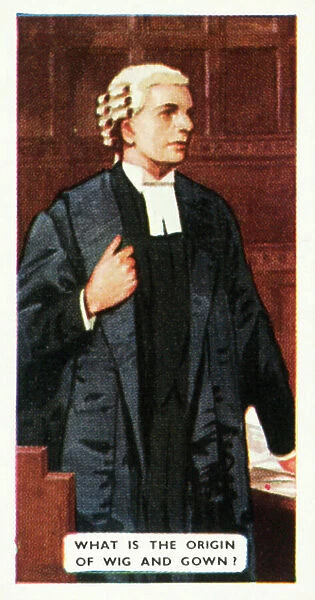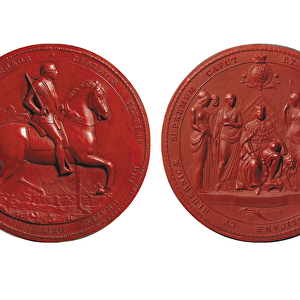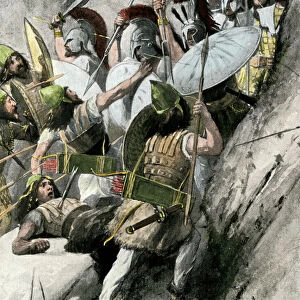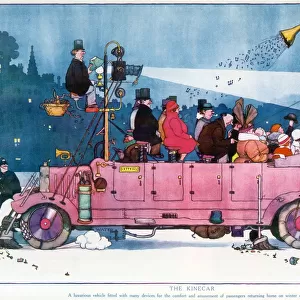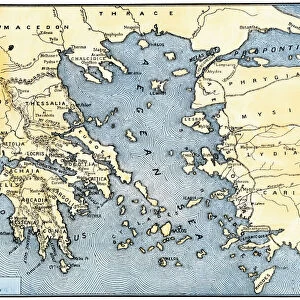Photo Mug > Arts > Artists > S > William Small
Photo Mug : Do You Know: What is the origin of wig and gown? (colour litho)
![]()

Home Decor from Fine Art Finder
Do You Know: What is the origin of wig and gown? (colour litho)
8668140 Do You Know: What is the origin of wig and gown? (colour litho) by English School, (20th century); Private Collection; (add.info.: What is the origin of wig and gown? Artificial hair has been worn all through history, and wigs from ancient Egypt, Persia and Greece are still preserved. Gentlemen's wigs became popular in England after 1660, when the full-bottomed wig was gradually replaced by a smaller peruke or tie-wig. In the latter half of the 18th century, the custom was slowly superseded, but the legal profession still retain the costume they adopted for mourning dress when Queen Mary (William and Mary) died of smallpox in 1694. Another statement exists that "the Bar went into mourning at the death of Queen Anne in 1714, and never came out again". Judges wear full-bottomed wigs, barristers wear tie-wigs. Illustration for one of a set of 50 "Do You Know?" cigarette cards issued by Carreras in 1939.); © Look and Learn
Media ID 38488564
© © Look and Learn / Bridgeman Images
Ailment Disease Grief Grieving Illness Iran Iranian Iranians Judge Judgement Judges Learn Mournful North African Persia Persians Sick Sickness Smallpox Wigmaker 18e Siecle 18th Century 18th Centuries 1930 1939 Years 30 30s 1930 1939 Years 30s 19301939 1933 34 Africa African African Deaths Dying Educating Egyptians General Knowledge Greece Greek Knowing Mortality Passed Away Years 1930 Years 30 Years Thirty
Large Photo Mug (15 oz)
Sip your morning coffee in style with our Photo Mug featuring the intriguing artwork "Do You Know: What is the origin of wig and gown?" by Bridgeman Images. Add a touch of art to your daily routine with this unique and thought-provoking design.
Elevate your coffee or tea experience with our premium white ceramic mug. Its wide, comfortable handle makes drinking easy, and you can rely on it to be both microwave and dishwasher safe. Sold in single units, preview may show both sides of the same mug so you can see how the picture wraps around.
Elevate your coffee or tea experience with our premium white ceramic mug. Its wide, comfortable handle makes drinking easy, and you can rely on it to be both microwave and dishwasher safe. Sold in single units, preview may show both sides of the same mug so you can see how the picture wraps around.
These are individually made so all sizes are approximate
FEATURES IN THESE COLLECTIONS
> Fine Art Finder
> Artists
> English School
> Arts
> Artists
> I
> Irish School Irish School
> Arts
> Artists
> I
> William Ireland
> Arts
> Artists
> S
> William Small
> Europe
> Greece
> Related Images
> Europe
> United Kingdom
> Northern Ireland
> Posters
> Europe
> United Kingdom
> Northern Ireland
> Related Images
> Historic
> Ancient civilizations
> Ancient Greece
> Greek history
EDITORS COMMENTS
This vibrant colour lithograph print titled "Do You Know: What is the origin of wig and gown?" by the English School from the 20th century offers a fascinating glimpse into the history of legal attire. The image showcases various styles of wigs worn throughout different time periods, highlighting the evolution of this traditional accessory.
Artificial hair has been a fashion staple for centuries, with wigs dating back to ancient civilizations such as Egypt, Persia, and Greece. In England, gentlemen's wigs gained popularity after 1660, eventually transitioning from full-bottomed wigs to smaller perukes or tie-wigs in the 18th century.
The legal profession adopted the iconic wig and gown attire for mourning dress following Queen Mary's death in 1694. Judges continue to wear full-bottomed wigs while barristers opt for tie-wigs as part of their professional attire.
This illustration was originally featured on a set of "Do You Know?" cigarette cards issued by Carreras in 1939, providing viewers with educational tidbits on various topics. The intricate details and historical significance captured in this print make it a valuable piece for those interested in sartorial history and cultural traditions.
MADE IN THE USA
Safe Shipping with 30 Day Money Back Guarantee
FREE PERSONALISATION*
We are proud to offer a range of customisation features including Personalised Captions, Color Filters and Picture Zoom Tools
SECURE PAYMENTS
We happily accept a wide range of payment options so you can pay for the things you need in the way that is most convenient for you
* Options may vary by product and licensing agreement. Zoomed Pictures can be adjusted in the Cart.


